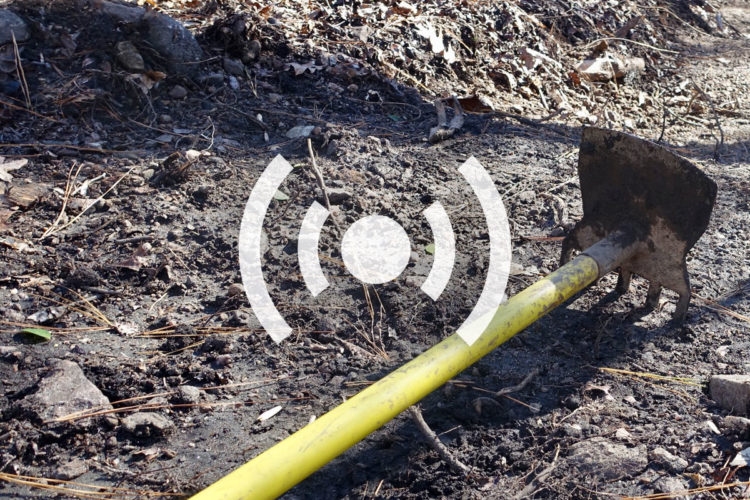How “illegal” is truly illegal when it comes to riding trails on your mountain bike? You’d think this would be an easy question to answer, but it’s not. You’d think that the distinction would be totally black and white, but it isn’t. Instead, over many years of mountain biking I’ve found that while we do have black and white at either end of the trail access spectrum, in between is a vast array of different shades of gray singletrack.
Paonia, Colorado
While the Singletracks staff has often discussed the varying level of gray trails, whether or not to display them in our database, how to determine the difference between which trails are ok to display and which are not, etc., this topic came flooding back to the surface for me on a recent trip to Paonia, Colorado. I had several trails on my hit list in the Paonia area, including one that’s listed in the Singletracks database as “Jumbo Mountain.” Unfortunately, we didn’t yet have a good map for that trail, so I went looking elsewhere. The best map I was able to find was in IMBA’s fledgling sanctioned trail database.

So when I arrived in town, I stopped in at a local store—not bike-specific—to try to pick up a trail map. Unfortunately, they didn’t have a map of Jumbo Mountain, and the guy there said, “I’m only aware of one good trail for mountain biking in the area, and it was built somewhat illegally by a bunch of mountain bikers.”
“Oh, that’s not good,” I said, while at the same time wondering what in the heck “somewhat illegally” meant.
“Yeah,” he responded, “if you go out of town thataway and go past a green gate, and turn left, you’ll see the trails out there.”
I decided not to go looking for the illegal trails, and instead to follow my GPS to the Jumbo Mountain trailhead. And what do you think I found? Yep, that’s right: the green gate, and a totally unmarked network of heavily-used singletrack–Jumbo Mountain was indeed the trail system the local was referring to. And out in that network of trails, I found plenty of other trail users, despite my mid-week ride time.
The Different Types of Gray Trails
At either end of the mountain bike access spectrum are white and black trails. White trails include all trails that are marked, with a sign, granting mountain bikes access to ride them. Black trails are trails that are marked, with a sign, proclaiming that mountain bikes are not allowed on them. Black trails also, unfortunately, include all Wilderness areas (regardless of signage), and other well-known trails that are off-limits to mountain bikes (like the Appalachian Trail and the Pacific Crest Trail). But in between those two extremes, there’s a lot of gray.
Here are several different types of gray trails that you’re likely to come across, roughly arranged in ascending order of illegality:
A trail that prohibits motorized use, but doesn’t expressly allow mountain bike use.
You’ll find many such trails and routes in the national forest. Generally, these trails are old road beds that have been shut down to motorized use, thanks to posted signs, rocks, dug-out bunkers, etc. But the implication of banning motorized use and not closing the route? That all other uses are still allowed, including all human-powered, and even equestrian, use.

A marked trail that doesn’t mention which uses are allowed.
I’ve seen many of these trails in Southern California, where you’ll often find a trail marker with a trail name, but no indication one way or another of what uses are or are not allowed there. As a result, I’ve dubbed the Los Angeles area “the Wild West of mountain biking.”

A trail that allows pedestrian (or another type) of use, but doesn’t specifically allow—or ban—mountain bike use.
If you see a little hiker on a trail sign, obviously that means that hiking is allowed. But does that mean that mountain biking is banned? Who can tell?
An old route on public land that’s no longer signed and maintained, but used to appear on maps.
Many of these historic trails and routes have not been rehabilitated, signed as closed, or otherwise blocked off—they simply exist, out in the forest, and few people know about them. They were, at least at one point, official trails, so using them doesn’t seem to be an issue—or is it?

An unsigned route on public lands, that’s never appeared on the map, and isn’t a part of the sanctioned trail system.
Generally speaking, a trail that meets these criteria has been built illegally—either via social off-trail use that’s resulted in a trail, or intentionally designed and built there. However, at times these trails occur from animal traffic, such as cows in open range areas.
Note: building a trail, without permission, on public lands in the US, is illegal across the board. No matter the land management agency, there’s always a law about disturbing, removing, or modifying resources without a permit. So do not mistake what I am saying: building such a trail is always in the black.
But once such a trail exists, its legal use, if it’s not marked as closed, is pretty ambiguous. Many, many trails fall into this category–including the Jumbo Mountain trails in Paonia.
Even within this single gray category, there often appears to be varying subsets of illegality. Some of these unmarked trails out in the forest are well-known to all the locals in town, to the Forest Service, and can often be the most heavily-used trails in the area. This was the case in Paonia.
On the other hand, some riders have attempted to hide and obscure the entrance to and exit from other unmarked trails, in an attempt to keep them under the radar of other local riders, tourists visiting the area, or even the Forest Service itself.

When the trail map, the trail sign, and/or the guidebook disagree on what uses are allowed.
This happens more than you’d think. I’ve seen two different maps from the same map maker disagree about the legality of a single trail. I’ve often rolled up to a trailhead hoping to ride a trail that’s marked as open to bikes on the map, only to find that it’s closed to bikes. But sometimes it goes the other way: I’ll spot a trail that’s signed as open to bikes, but the map says its closed.
When in doubt, I say go with the trail markers—if they specify.
When a trail is marked as closed to bikes on one end, but it doesn’t prohibit bikes on the other end.
This happens more than you’d imagine. Sometimes, this is just an issue of poor signage, so trying to argue this point isn’t a good idea.
However, I’ve observed trails where specific access points to the trail are marked as off-limits to bikes, but other access points that are more environmentally stable are marked as open to all non-motorized uses (see above), but don’t mention mountain bikes one way or another. So can you access the trail from one point, but not from another? It’s hard to say.
An unsigned route on private land, with unknown landownership.
You may encounter an unsigned trail that you think is most likely on private land, but there may not be a “No Trespassing” sign in place, and you may have no idea who owns the land. Heck, I’ve even ridden in places where it’s known that the land is private, but due to poor record keeping over the years, nobody actually knows who now owns the land. So it sits in indefinite limbo.
An unsigned route on private, corporately-owned land.
Technically-speaking, riding such a trail is trespassing in the United States. In other countries, though, that’s not the case, and in many instances in the US, said corporately-owned land is nowhere marked as such, there’s no current use of the land by the corporation, and no indication of who owns it or what its intended use is. Especially in urban areas, such as Atlanta, you’ll often find heavily-used trails on such land.
What leads to this grayness? Legal ambiguity.
What leads to these levels of grayness? The laws surrounding bike use in many places are ambiguous at best, and impossible to interpret at worst. For instance, in Colorado, some cyclists take Colorado laws to mean that, if a trail or a path isn’t marked as closed to mountain bikes, then by default it is open to bikes. This seems to be supported by section 10.c of the primary bike statute, which reads,
“A person riding or walking a bicycle or electrical assisted bicycle upon and along a sidewalk or pathway or across a roadway upon and along a crosswalk shall have all the rights and duties applicable to a pedestrian under the same circumstances, including, but not limited to, the rights and duties granted and required by section 42-4-802.”
These sweeping bicycle access laws can also be modified by local ordinance, either for or against bicycle access on sidewalks, trails, and other pathways. So, while Colorado law may perhaps allow blanket bike access, that bike access could be prohibited in one place by local ordinance, but allowed in the town next door.
And we’re just talking about Colorado here! All of this legalese varies from city to city, county to county, state to state, land management agency to land management agency, and nation to nation.
For instance, in the county I grew up in in Wisconsin, most of the public land was owned and managed by the county government. According to county law, mountain bikes are allowed anywhere and everywhere on the county forest, meaning you don’t even need a trail to legally ride your bike! But what about a trail that was once open to mountain bikes, and was then shut down and rehabilitated (simply by felling some trees across the entrance), but with no signs banning use? Well, based on the county officials who reached out and contacted me after I published an article about riding such a trail, what I did was illegal. Well, explain to me how the hell that makes sense if the law states that bikes are allowed everywhere on the county forest?
So what’s the verdict? If you come across an unmarked trail, can you legally ride it on your mountain bike? Well, nobody really knows.
Your Turn: Know of a different type of gray trail? Share it with us in the comments below!





















7 Comments
Nov 10, 2015
Nov 11, 2015
Here (wyoming ) it is your responsibility to know where you are. Private property does not need to be marked and public owned land does not mean you have access. You simply may not have the right to get to the land. Luckily asking usually works. Respect for the resource is important, regardless of who the owner is. One group abusing a privilege will shut it down for a long time. Read this as any land user, us with bikes will get lumped with atv users, off roaders, horse people, hunters ect.
A damaged trail/access road is a problem and can be expensive to fix. So we HAVE TO be responsible if we want access and trails.
So know who you ride on. The county usually knows, they send someone a tax bill.
Please know the difference between agencies they are all different and many do not have to develop trails for us.
Nov 9, 2015
Many land managers have way more than just trails and recreation to deal with. The last thing they want to do is create more work for themselves at a time when their resources are already stretched extremely thin. Most see the need to support human powered recreation, as it often aligns with their values of getting youth and urban dwellers outside and appreciating the natural world in a time when interest in the outdoors is on a decline.
The more people who can help us gain legitimacy as a user group the better. If you show up organized and willing to have a discussion of how mountain bikers can fit in to agencies goals, it's more likely they will help provide some options.
Nov 10, 2015
Story time ...Before I joined IMBA's staff about a decade ago I used to regularly ride a short stretch of trail on City of Boulder land that I kinda knew that it might be closed to bikes. One day a trail runner told me I couldn't be there, politely enough. I tried to argue that there was no sign suggesting it was closed and he told me where to look. He was right ... and a few months later I interviewed with the same guy, Pete Webber, and got a gig at IMBA. I didn't bring up our trail encounter!
Nov 9, 2015
It's also worth mentioning the latin phrase "Ignorantia juris non excusat": ignorance of law excuses no one. Just because a trail is gray doesn't mean you can't be held accountable for your actions if you're found to be in the wrong.
Nov 11, 2015
Specifically as it relates to mountain biking, I know about multiple cases from at least (2) riding areas here in San Diego where citations were dismissed due to lack of proper signage. One of them in an area such as Greg mentioned where there are signs on one end but not the other. All you need to do is argue that you came in from the side with no signs. Keep in mind, I did say "within reason" from the very beginning so use common sense.
May 31, 2019